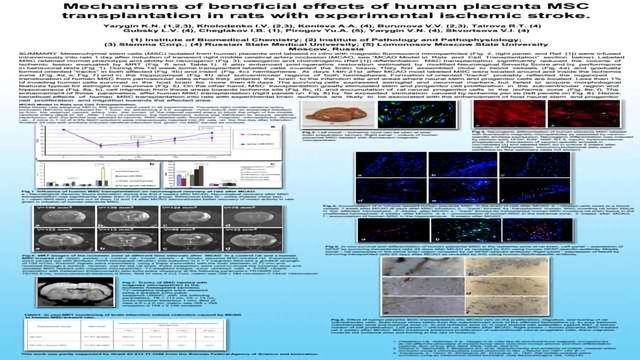Latest Posters

Poster
Clinical Evaluation of human embryonic stem cells (hESCs) induced with directed differentiation to gonadotrope cells to cure vasculogenic impotency and to improve coital frequency in males. An open st
This work demonstrates the clinical efficacy, tolerability and safety of patient-syngenic hESC induced with directed differentiation to gonadotrope cells. Hypothalamus transmits gonadotropin releasing factor to pituitary that sets off LH and FSH to Sertoli cell and Seminiferous tubule resulting Leydig cell to produces testosterone. This potential offers a rationale to evaluate hESCs to cure patients with vasculogenic impotency and to improve coital frequency in males.

Poster
Clinical Evaluation of induced pluripotent stem cells (iPSc) to cure patients with Psoriasis Vulgaris. An Open Study.
To evaluate the clinical efficacy of iPSc directed to interfere T-cell activation to cure patients with psoriasis. Twenty subjects were enrolled. Each patient was administered iv with syngenic iPS. Those showing lower PASI score were considered cured. The study states that induced iPSCs are safe and impart significant clinical efficacy to cure patients with psoriasis.

Poster
Cell Therapy Product Manufacturing in a Hospital Setting
This presentation describes in detail the development and establishment of a current good manufacturing practices (cGMP) facility for the purpose of manufacturing cell and tissue products intended for human use in a hospital setting.

Poster
Five noncovalent peptidic ligands show different affinity rankings in solution and gas phase
Stability of noncovalent complexes of VEGF protein with 5 peptidic ligands is studied. Experiments were conducted in solution (NMR CSP, ITC) and in gas phase (CID TOF MS). Each ligand differs from others in chirality of one amino acid. It was shown, that trend of stability of the studied noncovalent complexes is reversed in the gas phase relatively to the solution. An explanation of this behavior is presented.

Poster
PRESENTATION OF A NEW SOURCE FOR TEETH TISSUE ENGINEERING
Tooth regeneration is a biological technique to solving problems of tooth loss. The detection of various stem cells in unerupted tooth buds, dental pulp or bone marrow has provided opportunities for their management in dentin-pulp repair. However, these cells types are limited by: availability, invasiveness of extraction and in some cases limited proliferative capacity. Herein we hypothesized that endometrial adult stem cells could be induced into odontoblasts.

Poster
Correlation between the stem cells differentiation and topography of Zinc oxide nanorods
Since the conformation and symmetry may be equally important, we examine the order of nanorods on the surface to simulate the in vitro differentiation of stem cells and we revealed that stem cells respond differently to nanoscale features under the same conditions. Altering the orientation of nanotubular zinc oxide on the surface revealed changes in stem cell behaviour.

Poster
Evaluation of microfluidic digital PCR for the detection of cancer biomarkers
dPCR is achieved by sample partitioning prior to PCR amplification such that each reaction chamber contains one copy or less of target DNA. This dilution becomes the limiting factor and an accurate target molecule count is achievable. This study evaluates dPCR’s quantitative capabilities and investigates parameters influencing copy number quantification, using the Fluidigm Biomark instrument. Biomark technology combines dPCR theory with a microfluidics platform.

Poster
MitoProd patented technology for RNA manufacturing and its novel circular interfering RNA
Here is a description of MitoProd patented technology for RNA manufacturing, permitting a recurring production of RNA in industrial quantities. This technology enables the production of custom RNA at a gram scale, 99 % full length and 95% pure. MitoProd has also designed a new class of interfering RNA called ciRNA®, which have improved features such as RNAses resistance and an increased in vivo efficiency compared to siRNAs.

Poster
Inhibition of DNA methylation does not overcome docetaxel resistance in human breast cancer cells
DNA mehtylation can lead to chemotherapy resistance in cancer. The aim of this study was to investigate the role of DNA methylation in docetaxel-resistant human breast cancer cells. Whereas the DNA methylation machinery is altered in docetaxel-resistant human breast cancer cells compared to docetaxel-sensitive human breast cancer cells, resistance to docetaxel could not be reversed using the DNA methylation inhibitor decitabine.

Poster
Mechanisms of beneficial effects of human placenta MSC transplantation in rats with experimental ischemic stroke
Human MSC transplantation significantly reduced the volume of experimental ischemic lesion in rat model. It also greatly stimulated stem and progenitor cell proliferation in the subventricular region and hippocampus and cell migration from these areas towards the ischemia site. Beneficial effects of MSC in rats with brain ischemia are likely to be associated with enhancement of host neural stem and progenitor cell proliferation and migration towards the affected area.
Advertisement



